重庆医科大学:《妇产科学》课程教学大纲 A Teaching Outline for Obstetrics and Gynecology Course(中英文双语)
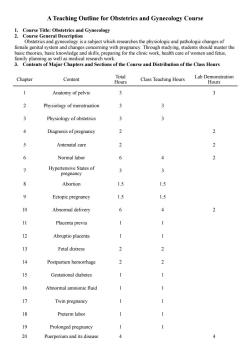
A Teaching Outline for Obstetrics and Gynecology Course zCaecti9iempadGncalhe asic theories,b ic knowledge an Contents of Major Chapters and Sections of the Course and Distribution of the Class Houry Tota Chapter Content Lab Der Hours Class Teaching Hours 1 Anatomy of pelvic 3 3 Physiology of menstruation 3 3 Physiology of obstetrics 3 Diagnosis of pregnancy 2 2 5 Antenatal care 6 Normal labor 6 7 Hypertensive States of 3 3 pregnancy 8 Abortion 1.5 9 Ectopic pregnancy 1.5 15 Abnormal delivery 6 11 Placenta previa 12 Abruptio placenta 1 Fetal distress 2 Postpartum hemorrhage 15 Gestational diabetes 1 1 6 Abnormal amnionic fluid 1 Twin pregnancy 18 Preterm labor 1 19 Prolonged pregnancy 20 Puerperium and its disease 4 4
A Teaching Outline for Obstetrics and Gynecology Course 1. Course Title: Obstetrics and Gynecology 2. Course General Description Obstetrics and gynecology is a subject which researches the physiologic and pathologic changes of female genital system and changes concerning with pregnancy. Through studying, students should master the basic theories, basic knowledge and skills, preparing for the clinic work, health care of women and fetus, family planning as well as medical research work. 3. Contents of Major Chapters and Sections of the Course and Distribution of the Class Hours Chapter Content Total Hours Class Teaching Hours Lab Demonstration Hours 1 Anatomy of pelvic 3 3 2 Physiology of menstruation 3 3 3 Physiology of obstetrics 3 3 4 Diagnosis of pregnancy 2 2 5 Antenatal care 2 2 6 Normal labor 6 4 2 7 Hypertensive States of pregnancy 3 3 8 Abortion 1.5 1.5 9 Ectopic pregnancy 1.5 1.5 10 Abnormal delivery 6 4 2 11 Placenta previa 1 1 12 Abruptio placenta 1 1 13 Fetal distress 2 2 14 Postpartum hemorrhage 2 2 15 Gestational diabetes 1 1 16 Abnormal amnionic fluid 1 1 17 Twin pregnancy 1 1 18 Preterm labor 1 1 19 Prolonged pregnancy 1 1 20 Puerperium and its disease 4 4
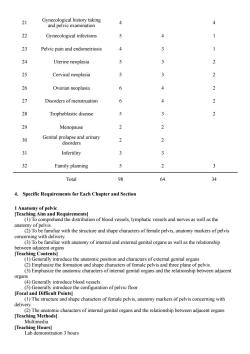
21 4 22 Gynecological infections 5 23 Pelvic pain and endometriosis 4 1 24 Uterine neoplasia 5 3 2 25 Cervical neoplasia 5 26 Ovarian neoplasia 6 27 Disorders of menstruation 6 4 2 28 Trophoblastic disease 5 3 2 29 Menopause 2 30 Genital prolapse and urinary disorders 2 31 Infertility 3 3 32 Family planning Total 98 64 34 4. Specific Requirements for Each Chapter and Section 1 Anatomy of pelvic [Teaching Aim and Requirements] (1)To comprehend the distribution of blood vessels,lymphatic vessels and nerves as well as the anatomy of pelvis. (2)To be familiar with the structure and shape characters of female pelvis,anatomy markers of pelvis concerning with delivery. (3)To be familiar with anatomy of internal and external genital organs as well as the relationship y introduce the anatomic nosition and characters of external genital organs (2)Emphasize the formation and shape char acters of female pelvis and th ane of pelvis. organs (4)Generally introduce blood vessels (5)Generally introduce the configuration of pelvic floor rp ceo fmeplvsmmscoe deliv (2)The anatomic characters of genital organs and the relationship between adjacent organs Teaching Methods] Multimedia [Teaching Hours] Lab demonstration 3 hours
21 Gynecological history taking and pelvic examination 4 4 22 Gynecological infections 5 4 1 23 Pelvic pain and endometriosis 4 3 1 24 Uterine neoplasia 5 3 2 25 Cervical neoplasia 5 3 2 26 Ovarian neoplasia 6 4 2 27 Disorders of menstruation 6 4 2 28 Trophoblastic disease 5 3 2 29 Menopause 2 2 30 Genital prolapse and urinary disorders 2 2 31 Infertility 3 3 32 Family planning 5 2 3 Total 98 64 34 4. Specific Requirements for Each Chapter and Section 1 Anatomy of pelvic [Teaching Aim and Requirements] (1) To comprehend the distribution of blood vessels, lymphatic vessels and nerves as well as the anatomy of pelvis. (2) To be familiar with the structure and shape characters of female pelvis, anatomy markers of pelvis concerning with delivery. (3) To be familiar with anatomy of internal and external genital organs as well as the relationship between adjacent organs [Teaching Contents] (1) Generally introduce the anatomic position and characters of external genital organs (2) Emphasize the formation and shape characters of female pelvis and three plane of pelvis. (3) Emphasize the anatomic characters of internal genital organs and the relationship between adjacent organs (4) Generally introduce blood vessels (5) Generally introduce the configuration of pelvic floor [Focal and Difficult Points] (1) The structure and shape characters of female pelvis, anatomy markers of pelvis concerning with delivery. (2) The anatomic characters of internal genital organs and the relationship between adjacent organs [Teaching Methods] Multimedia [Teaching Hours] Lab demonstration 3 hours
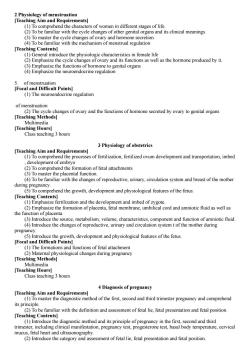
2Physiology of menstruation [Teaching Aim and Requirements] h the omen in difrerentsorgans and its clinical meanings. cycle change 10g the nd h (4)To be familiar with the mechans m of menstrual regulation [Teaching Contentsl (1)General introduce the physiologic characteristics in female life (2)Emphasize the cycle changes of ovary and its functions as well as the hormone produced by it. (3)Emphasize the functions of hormone to genital organs (4)Emphasize the neuroendocrine regulation (1)The neu endocrin ne regulation of menstruation (2)The cycle changes of ovary and the functions of hormone secreted by ovary to genital organs [Teaching Methods] 3 Physiology of obstetrics [Teaching Aim and Requirements] (1)To comprehend the processes of fertilization,fertilized ovum development and transportation,imbed development of embryo (2)To comprehend the formation of fetal attachments (3)To master the placental function (4)To be familiar with the changes of reproductive,urinary,circulation system and breast of the mother during pregnaney Teaching C ehend the growth,development and physiological features of the fetus (1Emphasize fertilization and the development and imbed of zygote. (2)Emphasize the formation of placenta,fetal membrane,umbilical cord and amniotic fluid as well as the function of placenta. (3)Introduce the source,metabolism,volume,characteristics,component and function of amniotic fluid. (4)Introduce the changes of reproductive.urinary and circulation system t of the mother during trodu and functions of fetal attachment (2)Mate du ing pregna [Teaching Methods Multimedia [Teaching Hours] Class teaching 3 hours 4 Diagnosis of pregnancy its principle (2)To be familiar with the definition and assessment of fetal lie.fetal presentation and fetal position [Teaching Contents] (1)Introduce the diagnostic method and its principle of pregnancy in the first,second and third trimester,including clinical manifestation,pregnancy test,progesterone test,basal body temperature,cervical mucus,fetal heart and ultrasonography. (2)Introduce the category and asse ssment of fetal lie,fetal presentation and fetal position
2 Physiology of menstruation [Teaching Aim and Requirements] (1) To comprehend the characters of women in different stages of life. (2) To be familiar with the cycle changes of other genital organs and its clinical meanings. (3) To master the cycle changes of ovary and hormone secretion (4) To be familiar with the mechanism of menstrual regulation [Teaching Contents] (1) General introduce the physiologic characteristics in female life (2) Emphasize the cycle changes of ovary and its functions as well as the hormone produced by it. (3) Emphasize the functions of hormone to genital organs (4) Emphasize the neuroendocrine regulation 5. of menstruation [Focal and Difficult Points] (1) The neuroendocrine regulation of menstruation (2) The cycle changes of ovary and the functions of hormone secreted by ovary to genital organs [Teaching Methods] Multimedia [Teaching Hours] Class teaching 3 hours 3 Physiology of obstetrics [Teaching Aim and Requirements] (1) To comprehend the processes of fertilization, fertilized ovum development and transportation, imbed , development of embryo (2) To comprehend the formation of fetal attachments (3) To master the placental function. (4) To be familiar with the changes of reproductive, urinary, circulation system and breast of the mother during pregnancy. (5) To comprehend the growth, development and physiological features of the fetus. [Teaching Contents] (1) Emphasize fertilization and the development and imbed of zygote. (2) Emphasize the formation of placenta, fetal membrane, umbilical cord and amniotic fluid as well as the function of placenta. (3) Introduce the source, metabolism, volume, characteristics, component and function of amniotic fluid. (4) Introduce the changes of reproductive, urinary and circulation system t of the mother during pregnancy. (5) Introduce the growth, development and physiological features of the fetus. [Focal and Difficult Points] (1) The formations and functions of fetal attachment (2) Maternal physiological changes during pregnancy [Teaching Methods] Multimedia [Teaching Hours] Class teaching 3 hours 4 Diagnosis of pregnancy [Teaching Aim and Requirements] (1) To master the diagnostic method of the first, second and third trimester pregnancy and comprehend its principle. (2) To be familiar with the definition and assessment of fetal lie, fetal presentation and fetal position. [Teaching Contents] (1) Introduce the diagnostic method and its principle of pregnancy in the first, second and third trimester, including clinical manifestation, pregnancy test, progesterone test, basal body temperature, cervical mucus, fetal heart and ultrasonography. (2) Introduce the category and assessment of fetal lie, fetal presentation and fetal position
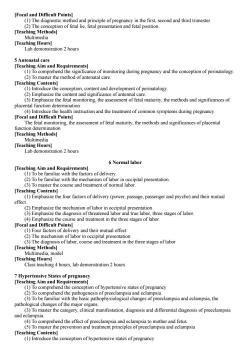
[Focal and Difficult Points] (1)The diagnostic method and principle of pregnancy in the first,second and third trimester Teae2)The gcception of fetal lie,fetal presentation and fetal position. [Teaching Ho Lab den onstration 2 hours 5 Antenatal care [Teaching Aim and Requirements] (1)To comprehend the significance of monitoring during pregnancy and the conception of perinatology (2)To master the method of antenatal care. [Teac hing Contents nte and development of perinatology. the methodsand of placental function determination (4)Introduce the health instruction and the treatment of common symptoms during pregnancy. [Focal and Difficult Points] The fetal monitoring,the assessment of fetal maturity,the methods and significances of placental function determinat Tea ning Me Tea r ration 2 hours 6 Normal labor [Teaching Aim and Requirements] (1)To be familiar with the factors of delivery. (2)To be familiar with the mechanism of labor in occipital presentation. 1o ma e course and treatment of normal labor Emphasize the four factors of delivery (power,passage,passenger and psyche)and their mutual (2)Emphasize the mechanism of labor in occipital presentation (3)Emphasize the diagnosis of threatened labor and true labor,three stages of labor. (4)Emphasize the course and treatment in the three stages of labor. [Focal and Difficult Points] (1)Four factors of delivery and their mutual effect [Teaching Hours] Class teaching 4 hours,lab demonstration 2 hours Hypertensive States of pregnancy [Teaching Aim and Requirements e conception of hypertensive state of pregnancy prehend t the nogenes and ecla of the hophysi anges of preeclampsia and eclampsia.the and eclamnsia (4)To comprehend the effect of preeclampsia and eclampsia to mother and fetus. (5)To master the prevention and treatment principles of preeclampsia and eclampsia [Teaching Contents] (1)Introduce the conception of hypertensive states of pregnancy
[Focal and Difficult Points] (1) The diagnostic method and principle of pregnancy in the first, second and third trimester (2) The conception of fetal lie, fetal presentation and fetal position. [Teaching Methods] Multimedia [Teaching Hours] Lab demonstration 2 hours 5 Antenatal care [Teaching Aim and Requirements] (1) To comprehend the significance of monitoring during pregnancy and the conception of perinatology. (2) To master the method of antenatal care. [Teaching Contents] (1) Introduce the conception, content and development of perinatology. (2) Emphasize the content and significance of antennal care. (3) Emphasize the fetal monitoring, the assessment of fetal maturity, the methods and significances of placental function determination (4) Introduce the health instruction and the treatment of common symptoms during pregnancy. [Focal and Difficult Points] The fetal monitoring, the assessment of fetal maturity, the methods and significances of placental function determination [Teaching Methods] Multimedia [Teaching Hours] Lab demonstration 2 hours 6 Normal labor [Teaching Aim and Requirements] (1) To be familiar with the factors of delivery. (2) To be familiar with the mechanism of labor in occipital presentation. (3) To master the course and treatment of normal labor. [Teaching Contents] (1) Emphasize the four factors of delivery (power, passage, passenger and psyche) and their mutual effect. (2) Emphasize the mechanism of labor in occipital presentation (3) Emphasize the diagnosis of threatened labor and true labor, three stages of labor. (4) Emphasize the course and treatment in the three stages of labor. [Focal and Difficult Points] (1) Four factors of delivery and their mutual effect (2) The mechanism of labor in occipital presentation (3) The diagnosis of labor, course and treatment in the three stages of labor [Teaching Methods] Multimedia, model [Teaching Hours] Class teaching 4 hours, lab demonstration 2 hours 7 Hypertensive States of pregnancy [Teaching Aim and Requirements] (1) To comprehend the conception of hypertensive states of pregnancy (2) To comprehend the pathogenesis of preeclampsia and eclampsia (3) To be familiar with the basic pathophysiological changes of preeclampsia and eclampsia, the pathological changes of the major organs. (3) To master the category, clinical manifestation, diagnosis and differential diagnosis of preeclampsia and eclampsia. (4) To comprehend the effect of preeclampsia and eclampsia to mother and fetus. (5) To master the prevention and treatment principles of preeclampsia and eclampsia [Teaching Contents] (1) Introduce the conception of hypertensive states of pregnancy
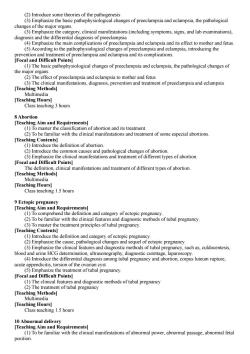
(2)Introduce some theories of the pathogenesis (3)Emphasize the basic pathophysiological changes of preeclampsia and eclampsia,the pathological 管 he major organs dia ry.clinical manifestations(including symptoms,signs,and lab examinations) (4)Emphasize the main compl catior and eclampsia and its effect to mother and fetus (5)According to the pathophys siological changes of preeclampsia and eclampsia,introducing the prevention and treatment of preeclampsia and eclampsia and its complications. [Focal and Difficult Points] (1)The basic pathophysiological changes of preeclampsia and eclampsia,the pathological changes of the ect of pre mpsia and eclampsia to mother and fetu manifestations,diagnosis,prevention and treatment of preeclampsia and eclampsia [Teaching Hours] Class teaching 3 hours 8Abortion [Teaching Aim and Requirements] of abortion and its treatment fa h the I manifestations and treatment of some especial abortions ce the definition of abortion (2)Introduce the common causes and pathological changes of abortion (3)Emphasize the clinical manifestations and treatment of different types of abortion. [Focal and Difficult Points] The definition,clinical manifestations and treatment of different types of abortion. [Teaching Methods] Multin edia Tea 9 Ectopic pregnancy [Teaching Aim and Requirements] (1)To comprehend the definition and category of ectopic pregnancy. (2)To be familiar with the clinical features and diagnostic methods of tubal pregnancy. (3)To master the treatment principles of tubal pregnancy. ce the definition and category of ectopic pregnaney (3)Em hasize the clinical featu and dia ti fubiepreg ncy such as culdocentesis blood and urine HCG det diag (4)Introduce the differential diagnosis among tubal pregnancy and abortion,corpus luteum rupture, acute appendicitis,torsion of the ovarian cyst (5)Emphasize the treatment of tubal pregnancy. [Focal and Difficult Points] (1)The clnical features and diagnostic methods of tubal pregnancy ent of tubal pregnancy [Teaching Hou Class teaching 1.5 hours 10 Abnormal delivery [Teaching Aim and Requirements] (1)To be familiar with the clinical manifestations of abnormal power,abnormal passage,abnormal fetal position
(2) Introduce some theories of the pathogenesis (3) Emphasize the basic pathophysiological changes of preeclampsia and eclampsia, the pathological changes of the major organs. (3) Emphasize the category, clinical manifestations (including symptoms, signs, and lab examinations), diagnosis and the differential diagnosis of preeclampsia (4) Emphasize the main complications of preeclampsia and eclampsia and its effect to mother and fetus. (5) According to the pathophysiological changes of preeclampsia and eclampsia, introducing the prevention and treatment of preeclampsia and eclampsia and its complications. [Focal and Difficult Points] (1) The basic pathophysiological changes of preeclampsia and eclampsia, the pathological changes of the major organs. (2) The effect of preeclampsia and eclampsia to mother and fetus (3) The clinical manifestations, diagnosis, prevention and treatment of preeclampsia and eclampsia [Teaching Methods] Multimedia [Teaching Hours] Class teaching 3 hours 8 Abortion [Teaching Aim and Requirements] (1) To master the classification of abortion and its treatment. (2) To be familiar with the clinical manifestations and treatment of some especial abortions. [Teaching Contents] (1) Introduce the definition of abortion. (2) Introduce the common causes and pathological changes of abortion. (3) Emphasize the clinical manifestations and treatment of different types of abortion. [Focal and Difficult Points] The definition, clinical manifestations and treatment of different types of abortion. [Teaching Methods] Multimedia [Teaching Hours] Class teaching 1.5 hours 9 Ectopic pregnancy [Teaching Aim and Requirements] (1) To comprehend the definition and category of ectopic pregnancy. (2) To be familiar with the clinical features and diagnostic methods of tubal pregnancy. (3) To master the treatment principles of tubal pregnancy. [Teaching Contents] (1) Introduce the definition and category of ectopic pregnancy. (2) Emphasize the cause, pathological changes and sequel of ectopic pregnancy. (3) Emphasize the clinical features and diagnostic methods of tubal pregnancy, such as, culdocentesis, blood and urine HCG determination, ultrasonography, diagnostic curettage, laparoscopy. (4) Introduce the differential diagnosis among tubal pregnancy and abortion, corpus luteum rupture, acute appendicitis, torsion of the ovarian cyst (5) Emphasize the treatment of tubal pregnancy. [Focal and Difficult Points] (1) The clinical features and diagnostic methods of tubal pregnancy (2) The treatment of tubal pregnancy [Teaching Methods] Multimedia [Teaching Hours] Class teaching 1.5 hours 10 Abnormal delivery [Teaching Aim and Requirements] (1) To be familiar with the clinical manifestations of abnormal power, abnormal passage, abnormal fetal position
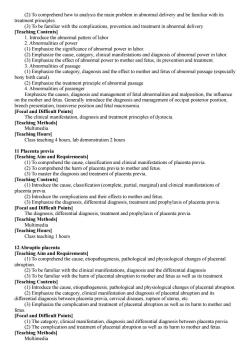
(2)To comprehend how to analysis the main problem in abnormal delivery and be familiar with its treatment principles. ng Conte ne at normal patters of labo (1)Emphasize the significance of abnormal power in labor. (2)Emphasize the cause.categ ry.clinical manifestations and diagnosis of abnormal power in labor. (3)Emphasize the effect of abnormal power to mother and fetus,its prevention and treatment. 3.Abnormalities of passage (1)Emphasize the category.diagnosis and the effect to mother and fetus of abnormal passage (especially bony birth canal) (2) siethe treatment principle of abnormal passage s and m tgementofocipulposileriorposition, preech presentation.transverse position and fetal macrosomia. [Focal and Difficult Points] The clinical manifestation,diagnosis and treatment principles of dystocia. [Teaching Methods] Multin edia 4boulabdmonou 11 Placenta previa [Teaching Aim and Requirements] (1)To comprehend the cause,classification and clinical manifestations of placenta previa. (2)To comprehend the harm of placenta previa to mother and fetus. (3)To master the diagnosis and treatment of placenta previa. [Teaching Contents] uce the cause,classification(complete,partial,marginal)and clinical manifestations of nd fet [Focal and Difficult Points] and prophylaxis of placenta previa The diagnosis,differential diagnosis,treatment and prophylaxis of placenta previa. [Teaching Methods] Multimedia [Teaching Hours] Class teaching 1 hours 12 Abruptio placenta [Teachin Ain use,etiopathogenesis,pathological and physiological changes of placental abruption. (2)To be familiar with the clinical manifestations,diagnosis and the differential diagnosis (3)To be familiar with the harm of placental abruption to mother and fetus as well as its treatment. [Teaching Contents] and physiologica omanddagnos ental abruption oI p ental a diffe (3)Emphasize the well as its harm to mother and fetus [Focal and Difficult Points] (1)The category,clinical manifestation,diagnosis and differential diagnosis between placenta previa (2)The complication and treatment of placental abruption as well as its harm to mother and fetus. [Teaching Methods] Multimedia
(2) To comprehend how to analysis the main problem in abnormal delivery and be familiar with its treatment principles. (3) To be familiar with the complications, prevention and treatment in abnormal delivery [Teaching Contents] 1. Introduce the abnormal patters of labor 2. Abnormalities of power (1) Emphasize the significance of abnormal power in labor. (2) Emphasize the cause, category, clinical manifestations and diagnosis of abnormal power in labor. (3) Emphasize the effect of abnormal power to mother and fetus, its prevention and treatment. 3. Abnormalities of passage (1) Emphasize the category, diagnosis and the effect to mother and fetus of abnormal passage (especially bony birth canal). (2) Emphasize the treatment principle of abnormal passage 4. Abnormalities of passenger Emphasize the causes, diagnosis and management of fetal abnormalities and malposition, the influence on the mother and fetus. Generally introduce the diagnosis and management of occiput posterior position, breech presentation, transverse position and fetal macrosomia. [Focal and Difficult Points] The clinical manifestation, diagnosis and treatment principles of dystocia. [Teaching Methods] Multimedia [Teaching Hours] Class teaching 4 hours, lab demonstration 2 hours 11 Placenta previa [Teaching Aim and Requirements] (1) To comprehend the cause, classification and clinical manifestations of placenta previa. (2) To comprehend the harm of placenta previa to mother and fetus. (3) To master the diagnosis and treatment of placenta previa. [Teaching Contents] (1) Introduce the cause, classification (complete, partial, marginal) and clinical manifestations of placenta previa. (2) Introduce the complications and their effects to mother and fetus. (3) Emphasize the diagnosis, differential diagnosis, treatment and prophylaxis of placenta previa. [Focal and Difficult Points] The diagnosis, differential diagnosis, treatment and prophylaxis of placenta previa. [Teaching Methods] Multimedia [Teaching Hours] Class teaching 1 hours 12 Abruptio placenta [Teaching Aim and Requirements] (1) To comprehend the cause, etiopathogenesis, pathological and physiological changes of placental abruption. (2) To be familiar with the clinical manifestations, diagnosis and the differential diagnosis (3) To be familiar with the harm of placental abruption to mother and fetus as well as its treatment. [Teaching Contents] (1) Introduce the cause, etiopathogenesis, pathological and physiological changes of placental abruption. (2) Emphasize the category, clinical manifestation and diagnosis of placental abruption and its differential diagnosis between placenta previa, cervical diseases, rupture of uterus, etc. (3) Emphasize the complication and treatment of placental abruption as well as its harm to mother and fetus. [Focal and Difficult Points] (1) The category, clinical manifestation, diagnosis and differential diagnosis between placenta previa (2) The complication and treatment of placental abruption as well as its harm to mother and fetus. [Teaching Methods] Multimedia
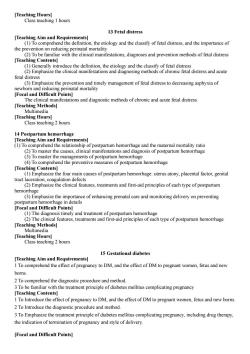
Teaching Hours] Class teaching I hours 13 Fetal distress [Teaching Aim and Re (1)To co mprehend the the tioloy and the classify of fetal distress,and the importance of the prevention on reducing pe rinatal mortality (2)To be familiar with the clinical manifestations,diagnoses and prevention methods of fetal distress [Teaching Contents] (1)Generally introduce the definition,the etiology and the classify of fetal distress hastz the ccal manitestations and diagnosing methods of chronic fetal distress an nd timely management of fetal distress to decreasing asphyxia of Focal and Difficult Points] The clinical manifestations and diagnostic methods of chronic and acute fetal distress. [Teaching Methods] Multimedia [Teaching Hours] Class teaching 2 hours 14 Postpartum he rrhage (m nts nd th f postpartum hemorrhage and the maternal mortality ratio (2)To master the causes.clinical manifestations and diagnosis of po stpartum hemorrhage (3)To master the managements of postpartum hemorrhage (4)To comprehend the preventive measures of postpartum hemorrhage [Teaching Contents] (1)Emphasize the four main causes of postpartum hemorrhage:uterus atony,placental factor,genita tract hem )Emphasize the im ortance of enhancing prenatal care and monitoring delivery on preventing Focal amd Dimc rtum hemorrhage in details (1)The diagnosis timely and treatment of postpartum hemorrhage (2)The clinical features,treatments and first-aid principles of each type of postpartum hemorrhage [Teaching Methods] m edia hing 2 hours 15 Gestational diabetes [Teaching Aim and Requirements] 1 To comprehend the effect of pregnancy to DM,and the effect of DM to pregnant women,fetus and new borns. ostic pro and method th the treatment principle of diabetes mellitus complicating pregnancy Contents thffct of pre o DM.and the efect of DMtoprm.fusm 2To Introduce the diagnostic procedure and method. 3 To Emphasize the treatment principle of diabetes mellitus complicating pregnancy,including drug therapy, the indication of termination of pregnancy and style of delivery. [Focal and Difficult Points]
[Teaching Hours] Class teaching 1 hours 13 Fetal distress [Teaching Aim and Requirements] (1) To comprehend the definition, the etiology and the classify of fetal distress, and the importance of the prevention on reducing perinatal mortality (2) To be familiar with the clinical manifestations, diagnoses and prevention methods of fetal distress [Teaching Contents] (1) Generally introduce the definition, the etiology and the classify of fetal distress (2) Emphasize the clinical manifestations and diagnosing methods of chronic fetal distress and acute fetal distress (3) Emphasize the prevention and timely management of fetal distress to decreasing asphyxia of newborn and reducing perinatal mortality [Focal and Difficult Points] The clinical manifestations and diagnostic methods of chronic and acute fetal distress. [Teaching Methods] Multimedia [Teaching Hours] Class teaching 2 hours 14 Postpartum hemorrhage [Teaching Aim and Requirements] (1) To comprehend the relationship of postpartum hemorrhage and the maternal mortality ratio (2) To master the causes, clinical manifestations and diagnosis of postpartum hemorrhage (3) To master the managements of postpartum hemorrhage (4) To comprehend the preventive measures of postpartum hemorrhage [Teaching Contents] (1) Emphasize the four main causes of postpartum hemorrhage: uterus atony, placental factor, genital tract laceration, coagulation defects (2) Emphasize the clinical features, treatments and first-aid principles of each type of postpartum hemorrhage (3) Emphasize the importance of enhancing prenatal care and monitoring delivery on preventing postpartum hemorrhage in details [Focal and Difficult Points] (1) The diagnosis timely and treatment of postpartum hemorrhage (2) The clinical features, treatments and first-aid principles of each type of postpartum hemorrhage [Teaching Methods] Multimedia [Teaching Hours] Class teaching 2 hours 15 Gestational diabetes [Teaching Aim and Requirements] 1 To comprehend the effect of pregnancy to DM, and the effect of DM to pregnant women, fetus and new borns. 2 To comprehend the diagnostic procedure and method. 3 To be familiar with the treatment principle of diabetes mellitus complicating pregnancy [Teaching Contents] 1 To Introduce the effect of pregnancy to DM, and the effect of DM to pregnant women, fetus and new borns. 2 To Introduce the diagnostic procedure and method. 3 To Emphasize the treatment principle of diabetes mellitus complicating pregnancy, including drug therapy, the indication of termination of pregnancy and style of delivery. [Focal and Difficult Points]
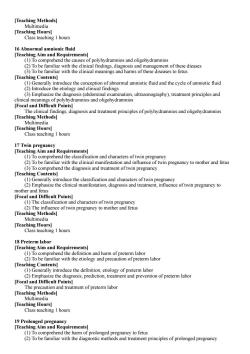
[Teaching Methods] ning 1 hours 16 Abnormal amnionic fluid ITeaching aim and requirementsl (1)To comprehend the causes of polyhydramnios and oligohydramnios (2)To be familiar with the clinical findings,diagnosis and management of these dieases (3)To be familiar with the clinical meanings and harms of these diseases to fetus [Teaching Contents] l amniot fuid and the cycle of miotl 3) clinical meanings of polyhydramnios and nation,ultrasonography),treatment principles and [Focal and Difficult Points] The clinical findings,diagnosis and treatment principles of polyhydramnios and oligohydramnios [Teaching Methods] Multimedia [Teaching Hours Class teaching I hours (the classification and characters of twin pregnancy (2)To be familiar with the clinical manifestation and influence of twin pregnancy to mother and fetus (3)To comprehend the diagnosis and treatment of twin pregnancy [Teaching Contents] nd pha size the clinical mar estation,diagnosis and treatment,influence of twin pregnancy to (1)The classification and characters of twin pregnancy The influence of twin preg ancy to mother and fetus [Teaching Methods] Multimedia [Teaching Hours] Class teaching 1 hours 18 Preterm labor ()Tocomprehend the definition and ha /11 n and harm of [Teaching Contents] (1)Generally introduce the definition,etiology of preterm labor (2)Emphasize the diagnosis,prediction,treatment and prevention of preterm labor [Focal and Difficult Points] [Teach [Teaching Ho Class teaching 1 hours 19 Prolonged pregnancy [Teaching Aim and Requirements] (1)To comprehend the harm of prolonged pregnancy to fetus (2)To be familiar with the diagnostic methods and treatment principles of prolonged pregnancy
[Teaching Methods] Multimedia [Teaching Hours] Class teaching 1 hours 16 Abnormal amnionic fluid [Teaching Aim and Requirements] (1) To comprehend the causes of polyhydramnios and oligohydramnios (2) To be familiar with the clinical findings, diagnosis and management of these dieases (3) To be familiar with the clinical meanings and harms of these diseases to fetus [Teaching Contents] (1) Generally introduce the conception of abnormal amniotic fluid and the cycle of amniotic fluid (2) Introduce the etiology and clinical findings (3) Emphasize the diagnosis (abdominal examination, ultrasonography), treatment principles and clinical meanings of polyhydramnios and oligohydramnios [Focal and Difficult Points] The clinical findings, diagnosis and treatment principles of polyhydramnios and oligohydramnios [Teaching Methods] Multimedia [Teaching Hours] Class teaching 1 hours 17 Twin pregnancy [Teaching Aim and Requirements] (1) To comprehend the classification and characters of twin pregnancy (2) To be familiar with the clinical manifestation and influence of twin pregnancy to mother and fetus (3) To comprehend the diagnosis and treatment of twin pregnancy [Teaching Contents] (1) Generally introduce the classification and characters of twin pregnancy (2) Emphasize the clinical manifestation, diagnosis and treatment, influence of twin pregnancy to mother and fetus [Focal and Difficult Points] (1) The classification and characters of twin pregnancy (2) The influence of twin pregnancy to mother and fetus [Teaching Methods] Multimedia [Teaching Hours] Class teaching 1 hours 18 Preterm labor [Teaching Aim and Requirements] (1) To comprehend the definition and harm of preterm labor (2) To be familiar with the etiology and precaution of preterm labor [Teaching Contents] (1) Generally introduce the definition, etiology of preterm labor (2) Emphasize the diagnosis, prediction, treatment and prevention of preterm labor [Focal and Difficult Points] The precaution and treatment of preterm labor [Teaching Methods] Multimedia [Teaching Hours] Class teaching 1 hours 19 Prolonged pregnancy [Teaching Aim and Requirements] (1) To comprehend the harm of prolonged pregnancy to fetus (2) To be familiar with the diagnostic methods and treatment principles of prolonged pregnancy
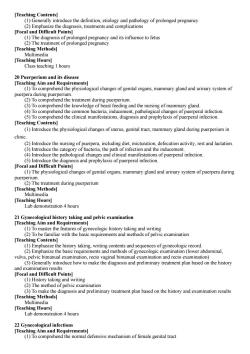
ITeaching Contents] Epe the definition,etiology and pathology of prolonged pregnancy sis,treatments and complications (T and its influence to fetus [Teaching Methods] Multimedia [Teaching Hours] Class teaching 1 hours erpe 20 Pu and its disease [Tea Aim ogical changes of genital organs,mammary gland and urinary system of durin erium (3)To comprehend the knowledge of beast feeding and the nursing of mammary gland. (4)To comprehend the common bacteria,inducement,pathological changes of puerperal infection. (5)To comprehend the clinical manifestations,diagnosis and prophylaxis of puerperal infection. [Teaching Contents] (1)Introduce the physiological changes of uterus,genital tract,mammary gland during puerperium in clinic he ca acteria,the pat (5)Introdu e a and prophyla is of puerpe al i [Focal and Difficult Points] (1)The physiological changes of genital organs,mammary gland and urinary system of puerpera during puerperium (2)The treatment during puerperium [Teaching Methods] Teachi edia ion 4 hours 21 Gynecological history taking and pelvic examination [Teaching Aim and Requirements] (1)To master the features of gynecologic history taking and writing (2)To be familiar with the basic requirements and methods of pelvic examination [Teaching Contents] the basic requiren ents and me tion(lower abdominal. vulv nd preliminary treatment plan ba n the history and examination results [Focal and Difficult Points] (1)History taking and writing (2)The method of pelvic examination (3)To make the diagnosis and preliminary treatment plan based on the history and examination results [Teaching Methods] ation 4 hours 22 Gynecological infections [Teaching Aim and Requirements] (1)To comprehend the normal defensive mechanism of female genital tract
[Teaching Contents] (1) Generally introduce the definition, etiology and pathology of prolonged pregnancy (2) Emphasize the diagnosis, treatments and complications [Focal and Difficult Points] (1) The diagnosis of prolonged pregnancy and its influence to fetus (2) The treatment of prolonged pregnancy [Teaching Methods] Multimedia [Teaching Hours] Class teaching 1 hours 20 Puerperium and its disease [Teaching Aim and Requirements] (1) To comprehend the physiological changes of genital organs, mammary gland and urinary system of puerpera during puerperium. (2) To comprehend the treatment during puerperium. (3) To comprehend the knowledge of beast feeding and the nursing of mammary gland. (4) To comprehend the common bacteria, inducement, pathological changes of puerperal infection. (5) To comprehend the clinical manifestations, diagnosis and prophylaxis of puerperal infection. [Teaching Contents] (1) Introduce the physiological changes of uterus, genital tract, mammary gland during puerperium in clinic. (2) Introduce the nursing of puerpera, including diet, micturation, defecation activity, rest and lactation. (3) Introduce the category of bacteria, the path of infection and the inducement. (4) Introduce the pathological changes and clinical manifestations of puerperal infection. (5) Introduce the diagnosis and prophylaxis of puerperal infection. [Focal and Difficult Points] (1) The physiological changes of genital organs, mammary gland and urinary system of puerpera during puerperium. (2) The treatment during puerperium [Teaching Methods] Multimedia [Teaching Hours] Lab demonstration 4 hours 21 Gynecological history taking and pelvic examination [Teaching Aim and Requirements] (1) To master the features of gynecologic history taking and writing (2) To be familiar with the basic requirements and methods of pelvic examination [Teaching Contents] (1) Emphasize the history taking, writing contents and sequences of gynecologic record. (2) Emphasize the basic requirements and methods of gynecologic examination (lower abdominal, vulva, pelvic bimanual examination, recto vaginal bimanual examination and recto examination) (3) Generally introduce how to make the diagnosis and preliminary treatment plan based on the history and examination results [Focal and Difficult Points] (1) History taking and writing (2) The method of pelvic examination (3) To make the diagnosis and preliminary treatment plan based on the history and examination results [Teaching Methods] Multimedia [Teaching Hours] Lab demonstration 4 hours 22 Gynecological infections [Teaching Aim and Requirements] (1) To comprehend the normal defensive mechanism of female genital tract
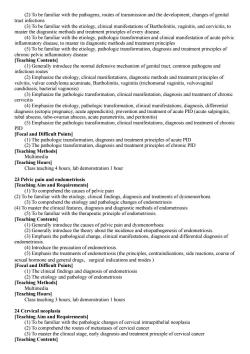
(2)To be familiar with the pathogens.routes of transmission and the development.changes of genital tract infections (3)To be familiar with the etiology,clinical manifestations of Bartholinitis,vaginitis,and cervicitis,to maste the tment prin les of every diseas dis to gy,patn tho nd tr (5)To be familiar with the etiology,pathologie transforr mat diagno osis and treatment principles of chronic pelvic inflammatory disease [Teaching Contents] (1)Generally introduce the normal defensive mechanism of genital tract common pathogens and infectious routes ()Emphasize the tioloy,methods and treatment principles of dyloma acuminate,Bartholinitis,vaginitis (trichomonal vaginitis,vulvovagina Empha the P ologic transformation,clinical manifestation,diagnosis and treatment of chronic cervicitis (4)Emphasize the etiology.pathologic transformation clinical manifestations.diagnosis.differential diagnosis(ectopic pregnancy,acute appendicitis),prevention and treatment of acute PID(acute salpingitis, tubal abscess,tubo-ovarian abscess,acute parametritis,and peritonitis) (5)Emphasize the pathologic transformation.clinical manifestations.diagnosis and treatment of chronic PID Focal and Difficult Points e pa PID [Teaching Methods] Multimedia [Teaching Hours] Class teaching 4 hours lab demonstration i hour ing Aim an comprehe the cau s of an rea (3)To com rehend the nd r h (4)To master the clinical feature nosis and diag stic methods of endometriosis (5)To be familiar with the therapeutic principle of endometriosis. [Teaching Contents] (1)Generally introduce the causes of pelvic pain and dysmenorrhoea (2)Generally introduce the theory about the incidence and etiopathogenesis of endometriosis (mphasisth (4)Int phasis the prec duce the 5)Em riosis(the principl s,contraindications,side reactions,course of rugs,surgical indications and modes) and diagnosis of endometriosis (2)The etiology and pathology of endometriosis [Teaching Methods] Multimedia [Teaching Hours] Class teaching 3 hours,lab demonstration I hours 24 Cervical neoplasis (To be ilia with the pathologic changes s of cervical intraepithelial neoplasia (2)To com orehend the outes of m etastases of cer vical cancer (3)To master the clinical stage.early diagnosis and treatment principle of cervical cancer [Teaching Contents]
(2) To be familiar with the pathogens, routes of transmission and the development, changes of genital tract infections (3) To be familiar with the etiology, clinical manifestations of Bartholinitis, vaginitis, and cervicitis, to master the diagnostic methods and treatment principles of every disease. (4) To be familiar with the etiology, pathologic transformation and clinical manifestation of acute pelvic inflammatory disease, to master its diagnostic methods and treatment principles (5) To be familiar with the etiology, pathologic transformation, diagnosis and treatment principles of chronic pelvic inflammatory disease [Teaching Contents] (1) Generally introduce the normal defensive mechanism of genital tract, common pathogens and infectious routes (2) Emphasize the etiology, clinical manifestations, diagnostic methods and treatment principles of vulvitis, vulvar condyloma acuminate, Bartholinitis, vaginitis (trichomonal vaginitis, vulvovaginal candidiasis, bacterial vaginosis) (3) Emphasize the pathologic transformation, clinical manifestation, diagnosis and treatment of chronic cervicitis (4) Emphasize the etiology, pathologic transformation, clinical manifestations, diagnosis, differential diagnosis (ectopic pregnancy, acute appendicitis), prevention and treatment of acute PID (acute salpingitis, tubal abscess, tubo-ovarian abscess, acute parametritis, and peritonitis) (5) Emphasize the pathologic transformation, clinical manifestations, diagnosis and treatment of chronic PID [Focal and Difficult Points] (1) The pathologic transformation, diagnosis and treatment principles of acute PID (2) The pathologic transformation, diagnosis and treatment principles of chronic PID [Teaching Methods] Multimedia [Teaching Hours] Class teaching 4 hours, lab demonstration 1 hour 23 Pelvic pain and endometriosis [Teaching Aim and Requirements] (1) To comprehend the causes of pelvic pain (2) To be familiar with the etiology, clinical findings, diagnosis and treatments of dysmenorrhoea (3) To comprehend the etiology and pathologic changes of endometriosis (4) To master the clinical features, diagnosis and diagnostic methods of endometriosis (5) To be familiar with the therapeutic principle of endometriosis. [Teaching Contents] (1) Generally introduce the causes of pelvic pain and dysmenorrhoea (2) Generally introduce the theory about the incidence and etiopathogenesis of endometriosis. (3) Emphasis the pathological change, clinical manifestations, diagnosis and differential diagnosis of endometriosis. (4) Introduce the precaution of endometriosis. (5) Emphasis the treatments of endometriosis (the principles, contraindications, side reactions, course of sexual hormone and general drugs,surgical indications and modes ) [Focal and Difficult Points] (1) The clinical findings and diagnosis of endometriosis (2) The etiology and pathology of endometriosis [Teaching Methods] Multimedia [Teaching Hours] Class teaching 3 hours, lab demonstration 1 hours 24 Cervical neoplasia [Teaching Aim and Requirements] (1) To be familiar with the pathologic changes of cervical intraepithelial neoplasia (2) To comprehend the routes of metastases of cervical cancer (3) To master the clinical stage, early diagnosis and treatment principle of cervical cancer [Teaching Contents]
按次数下载不扣除下载券;
注册用户24小时内重复下载只扣除一次;
顺序:VIP每日次数-->可用次数-->下载券;
- 《儿科学》课程教学课件(PPT讲稿)01 Introduction of Pediatrics.pptx
- 《儿科学》课程教学课件(PPT讲稿)02 Growth.pptx
- 《儿科学》课程教学课件(PPT讲稿)03 Development.pptx
- 《儿科学》课程教学课件(PPT讲稿)04 Nutrition During Childhood.pptx
- 《儿科学》课程教学课件(PPT讲稿)05 Neonatal Jaundice,Hemolytic Disease of Newborn.pptx
- 《儿科学》课程教学课件(PPT讲稿)08 Respiratory Disorders.pptx
- 《儿科学》课程教学课件(PPT讲稿)09 Congenital Heart Disease.pptx
- 《儿科学》课程教学课件(PPT讲稿)10 Haematopoiesis and Blood Cell Counts.pptx
- 《儿科学》课程教学课件(PPT讲稿)11 Nutritional Iron Deficiency Anemia.pptx
- 《儿科学》课程教学课件(PPT讲稿)12 Acute Convulsion in Children.pptx
- 《儿科学》课程教学课件(PPT讲稿)13 Acute Glomerulonephritis,Nephrotic Syndrome.pptx
- 《儿科学》课程教学课件(PPT讲稿)14 Immunodeficiency.pptx
- 《儿科学》课程教学课件(PPT讲稿)15 Congenital Hypothyroidism.pptx
- 《儿科学》课程教学课件(PPT讲稿)16 Growth Hormone Deficiency.pptx
- 《儿科学》课程教学课件(PPT讲稿)17 Measles.pptx
- 《儿科学》课程教学课件(PPT讲稿)18 Varicella.pptx
- 《儿科学》课程教学课件(PPT讲稿)19 Pediatric Tuberculosis.pptx
- 《儿科学》课程教学课件(PPT讲稿)22 Infantale Diarrhea and Fluid Therapy.pptx
- 《儿科学》课程教学课件(PPT讲稿)23 Infantile Hepatitis Syndrome.pptx
- 《儿科学》课程教学课件(PPT讲稿)24 Mumps(Epidemic parotitis).pptx
- 重庆医科大学:《妇产科学》课程授课教案(中文)06 妊娠期高血压疾病.doc
- 重庆医科大学:《妇产科学》课程授课教案(中文)04 异位妊娠.doc
- 重庆医科大学:《妇产科学》课程授课教案(中文)05 正常分娩.doc
- 重庆医科大学:《妇产科学》课程授课教案(中文)03 流产.doc
- 重庆医科大学:《妇产科学》课程授课教案(中文)01 月经生理.doc
- 重庆医科大学:《妇产科学》课程授课教案(中文)02 妊娠生理.doc
- 重庆医科大学:《妇产科学》课程授课教案(中文)09 妊娠期肝内胆汁淤积症.doc
- 重庆医科大学:《妇产科学》课程授课教案(中文)07 妊娠合并心脏病.doc
- 重庆医科大学:《妇产科学》课程授课教案(中文)08 妊娠合并糖尿病.doc
- 重庆医科大学:《妇产科学》课程授课教案(中文)10 妊娠合并病毒性肝炎.doc
- 重庆医科大学:《妇产科学》课程授课教案(中文)11 前置胎盘.doc
- 重庆医科大学:《妇产科学》课程授课教案(中文)12 胎盘早期剥离.doc
- 重庆医科大学:《妇产科学》课程授课教案(中文)13 胎儿窘迫.doc
- 重庆医科大学:《妇产科学》课程授课教案(中文)14 产后出血.doc
- 重庆医科大学:《妇产科学》课程授课教案(中文)15 女性生殖系统炎症.doc
- 重庆医科大学:《妇产科学》课程授课教案(中文)16 子宫颈癌.doc
- 重庆医科大学:《妇产科学》课程授课教案(中文)17 子宫肌瘤.doc
- 重庆医科大学:《妇产科学》课程授课教案(中文)18 子宫内膜癌.doc
- 重庆医科大学:《妇产科学》课程授课教案(中文)19 卵巢肿瘤.doc
- 重庆医科大学:《妇产科学》课程授课教案(中文)20 妊娠滋养细胞疾病.doc
